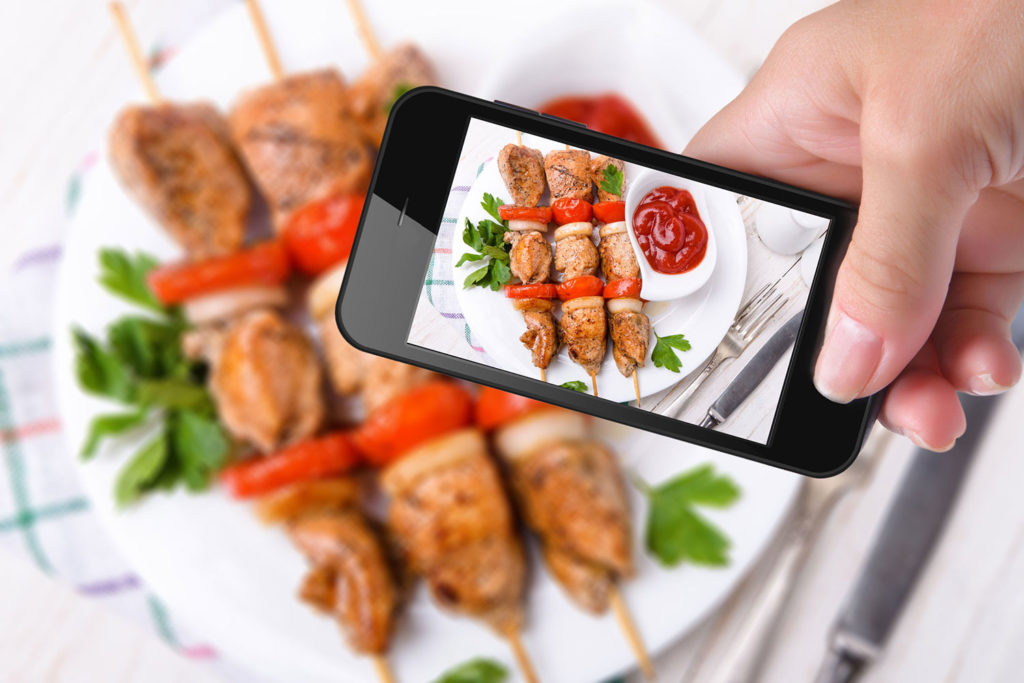 Last week, I was out for brunch with my parents. Upon a gorgeous, steaming-hot goat cheese-filled egg white omelet arriving in front of me, I whipped out my phone, stood on my chair and snapped about 10 different photos—all from different angles—praying one was perfect enough to post on my Instagram.
Last week, I was out for brunch with my parents. Upon a gorgeous, steaming-hot goat cheese-filled egg white omelet arriving in front of me, I whipped out my phone, stood on my chair and snapped about 10 different photos—all from different angles—praying one was perfect enough to post on my Instagram.
My mom, obviously (and understandably) embarrassed, leaned over to me and said, “Maybe you shouldn’t do that; you’re making a scene.” She was right—I was making a scene, but I’m also a millennial, and that’s what millennials do. Our skill: making you desire what we’re having.
Yes, it’s now a prerequisite to take photos—or videos—or Boomerangs of your meals or drinks and post them on Instagram, or other social channels – and this need is influencing the ever-evolving food and restaurant industry.
What to Eat and Where to Eat
Not only are we using the photo-sharing social network to document what we’re eating, we’re using it to decide where to eat too. According to research conducted by the restaurant chain Zizzi in the United Kingdom— as referenced in Rachel Hosie’s article in The Independent, “How Instagram Has Transformed the Restaurant Industry For Millennials,”18-35-year-olds spend five whole days a year browsing food images on Instagram, and 30 percent would avoid a restaurant if their Instagram presence wasn’t up to snuff. “All my friends check out a restaurant’s Instagram page to see what we want when we go out for a meal,” 23-year-old Londoner Georgie told the paper.
The fact is, it’s now normal to sit down in a restaurant having already decided what you’re going to order because you’ve spent a few minutes sifting through menu offerings on Instagram on the ride over. Instagram and social media are word-of-mouth marketing for today’s millennials, and can help build a restaurant’s reputation just as quickly as they can break it. “It affects me when I see a bad review,” says chef Ned Bell of the Four Seasons Hotel in Vancouver, in a recent interview in Wired Magazine. “But it affects me more when someone takes a bad photo of my food. I worry about what my food looks like on the social media world.”
We Crave the Superlatives
With more than 178 million photos tagged #food on Instagram and 56 million tagged #foodporn (according to Wired), the world’s largest, most delicious, spiciest, juiciest and most utterly transcendent food has all been documented for us. So how do you stand out among 178 million competitive peers? You one-up them, of course—you post an even bigger, more delicious, spicier or more utterly transcendent dish that outshines the rest. If you can’t do that, you find the trendiest, fanciest, or most expensive restaurant. Ever heard of a “humblebrag?” As stated by James Hall in his article in The Telegraph, “Instagram has dramatically changed the nation’s eating habits – and that’s no bad thing,” “When someone posts and tags a picture of their dish at The Ivy, are they really showing us the steak in front of them, or are they signposting that they’re at dining in one of London’s most exclusive eateries?
The answer seems depressingly obvious. This principal has also given rise to what The Switch refers to as “culinary tourism” – yes, it’s an actual thing. The aim is to make others want what you’re having—and the key is in the superlatives.
It May…Make Food Taste Better?
A recent survey published in the Journal of Consumer Marketing suggests that the act of taking a picture before eating — including the light-changing and angle-tweaking — can actually make food taste better. Perhaps Claudia McNeilly, a reporter for New York Magazine, best explains the science behind the “phenomenon.” As she states in her article, “The Psychological Case for Instagramming Your Food,” “You’re interacting with what’s on your plate. There are camera angles, lighting, composition, and the placement of forks and knives to consider. All of this takes time and puts off any actual eating that might otherwise be happening, building anticipation for what’s to come. When you do eventually go to take that first bite, the experience ends up tasting that much sweeter.” It’s this implicit link between pleasure and photography that explains why someone who is used to taking photos of their food might—almost robotically—take out their smartphone at the dinner table immediately upon sitting down or receiving their meal. If it increases our satisfaction, why not keep doing it?
It Can be a Helpful Research Tool
Instagram can be a helpful research tool for restaurateurs and chefs. Many chefs have accounts, of course. Celebrity chef Bobby Flay has more than 657,000 followers, while Chef Jamie Oliver has some 5.8 million. They watch each other, extracting ideas based on what guests are most drawn to and engage most with.
“Instagram makes trends. Everybody draws a line of sauce in the same way. Because one chef sees it, another sees it,” says chef Anthony Walsh of Toronto’s Olivier & Bonacini in Wired Magazine. “Before you had to go to a restaurant to see and taste a dish. Now you can see dishes, how they make it.”
In fact, Chef Jair Tellez from MeroToro in Mexico City does this himself. “I like to check from time to time,” he says. “What is Rene Redzepi doing at Noma or Inaki Aizpitarte from Le Chateaubriand? If I like the color scheme, technique, plate or combination of ingredients, I can duplicate it in my own kitchen. It’s about sharing ideas. Before there were cookbooks, now it’s more accessible.”
So, What Does This Mean for Us?
As PR pros, it means that social media continues to heavily influence the success of virtually every major (and minor) brand—whether that be a client or a client’s competitor. It also means that for restaurant and food clients, social media can be a helpful barometer to see what’s sticking and what’s not—what consumers are engaging with most and what’s falling flat. And for us personally, it means that we all have our very own magazine of sorts, full of the most beautiful and jealousy-inducing photos we can create—and that those photos influence others much, much more than we may know.
For more information about our Food + Beverage practice, click here.
